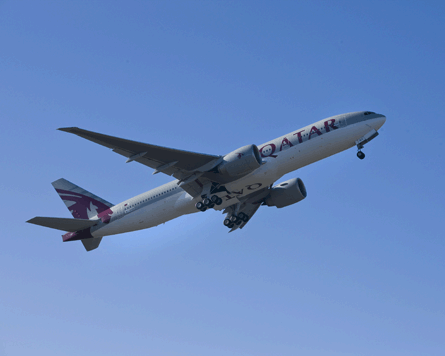The world may be facing one of the worst economic crises in recent history, but nobody has told Qatar Airways. The airline, which has developed itself into a global network carrier in the space of a decade serving more than 80 destinations, does not intend to let the current global slump interfere with its expansion.
"We are not going to slow down," says chief executive Akbar Al Baker. "Qatar Airways is very clever at shifting capacity and having the courage to source new markets. We are redeploying our capacity, adding destinations and increasing frequencies to existing points."
Like Gulf neighbours Abu Dhabi and Oman, Qatar was once a quarter shareholder of the region's original network carrier Gulf Air, but like the others decided to abandon the partnership in favour of the full-on development of a national carrier in which it holds a 50% stake. While Gulf Air's presence on the global stage has shrunk as it regrouped around a single hub in Bahrain, the remaining shareholder, the airline of natural-resource-rich Qatar has gone from strength to strength. It currently employs 10,000 staff (plus 4,500 with subsidiary companies such as aviation services and catering), operates a fleet of 68 mostly widebody Airbus and Boeing aircraft, and serves 84 destinations in Europe, Asia, Africa and North America. A new arm to its network should come on line before the year is out when direct services begin to Australia.
 |
|---|
© Qatar Airways |
"We have probably doubled in size over the last five years," says Qatar Airways executive vice-president human resources, Rosemary Fagen. "We have averaged 30-35% annual growth for the last three to four years at least and we are going to maintain that growth path wherever possible."
Fagen says the airline's strategy is "a little bit unique in that while many other parts of the industry are retracting, it is a deliberate strategy to maintain our 'growth rage'". However, she acknowledges that the global downturn will eventually have an impact on Qatar - "but it hasn't been significant yet".
If the growth rate continues as planned, the airline will need to find between 7,000 and 10,000 more employees over the next two or three years, says Fagen. Qatar's central location in the world will help with this task because it allows the airline to look "north, south, east and west", she adds.
"We are very clever at shifting capacity and having courage to source new markets"Akbar Al BakerQatar Airways chief executive |
|---|
"We had struggled to find certain talents in the past, but we don't any more as legacy airlines are parking aircraft and their pilots, cabin crew and engineers are looking towards the Middle East for opportunities. Pilots and engineers also get very excited about the opportunity to work with new aircraft technology, which Qatar Airways can offer through its young fleet of the latest airliners."
Fagen says that as other airlines are downsizing, Qatar Airways is being "opportunistic - if they have type-rated pilots we have openings for, we've been having one-to-one talks with the airlines".
Qatar Airways employs about 1,000 pilots, the vast majority of whom are expatriates. Apart from Qatari nationals training at the country's aviation college, the carrier generally recruits type-rated pilots.
Minimum requirements for captains are 6,000h with at least 2,000h in command, of which 1,500h must have been on a jet and 500h on type, says Fagen. First officers must have at least 1,000h, including 500h on type. "All pilots need to have the ICAO ATPL and English proficiency level," she adds.
A rating on one of the types in the Qatar Airways fleet is preferred, but Fagen says an allowance has sometimes been made. "For example, we have offered pilots with considerable experience on other Boeing aircraft type-rating conversion onto the 777, which we can provide at our in-house training centre."
 |
|---|
© Boeing |
One positive aspect of the economic downturn is that it has helped to all but eliminate the costly "churn" of pilots and engineers between Qatar Airways and the Gulf carriers, says Fagen. "This factor, combined with the attraction of the new aircraft technology we have to offer and Qatar's investment in infrastructure that has made the country a far more attractive proposition, means that churn has all but dried up."
Like its local rivals, Qatar Airways operates a single-base system for its flight and crews, who must reside in Doha.
Its 3,100 cabin crew comprise 86 nationalities - a reflection of its global customer base, says Fagen. The carrier takes a mix of new recruits to train in house, plus experienced flight attendants from other carriers. "We believe it is good to employ both very fresh and experienced people to have a balance of the skills inside the cabin to offer a high standard of customer service," says Bandula Saputhanthiri, vice-president cabin services.
"We offer one of the fastest career growth curves that cabin crew can have," he adds. Although flight attendants recruited with experience on other airlines have to start on the "bottom rung", the airline's fast-track system enables them to progress rapidly.
Fagen says Qatar Airways' package for flight and cabin crew includes the "standard set of benefits offered by airlines globally, along with some key fundamental housekeeping requirements" that all the region's carriers need to provide because they are focused primarily on recruiting expatriates. "Things like housing, transport and medical coverage are critical to any remuneration benefits offering," she says. "From a base-pay point of view, we simply wouldn't be able to get people if we didn't offer a competitive rate."
Source: Flight International



















